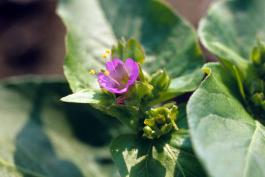
Smooth-stemmed perennial, branching above, with stems nearly square, generally hairless except near the flower stalks. Flowers in many-flowered terminal panicles, small, arising from a green, 5-lobed leafy involucre; there are no true petals; sepals are petal-like, fused into a trumpet shape, light pink to purple; stamens 3–5, protruding, with yellow tips. Blooms May–October. Called “four-o’clock” because the flowers open in late afternoon. Leaves opposite, heart-shaped or triangular, to 3½ inches long, on petioles (leaf stalks) (except a few of the uppermost leaves; this is the only Mirabilis in Missouri with petioles).
Similar species: White four-o'clock (M. albida) has narrowly lanceolate or oblong leaves without stalks, white, lilac or pink flowers, and grows on bluff edges, glades, and other dry sites. Narrow-leaved four-o'clock (M. linearis) has very narrow (linear) leaves and is quite rare in Missouri.
Height: to 2½ feet.

Statewide.
Habitat and Conservation
Occurs in old fields, pastures, prairies, waste places, roadways, and railroads, often in poor soils. Botanists believe that this species originally grew only in the West, and that it was introduced farther east, into our area. It does best in disturbed places, as along railroads where it roots into the ballast.
Human Connections
This plant is apparently toxic, and most livestock avoid eating it. In heavily grazed areas, wild four-o'clock tends to increase. Native Americans used this plant for a variety of medicinal purposes.
Ecosystem Connections
The trumpet-shaped flowers are visited by bees, moths, and perhaps hummingbirds. At least one moth species, Neoheliodines nyctaginella, uses members of this genus as its larval food plant. The leaf-footed bug Catorhintha mendica feeds specifically on four-o'clocks, too.

























